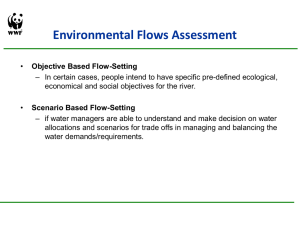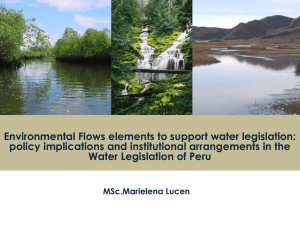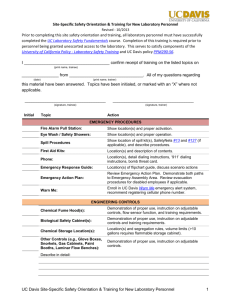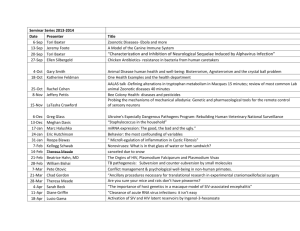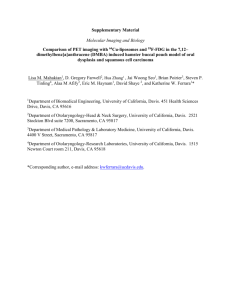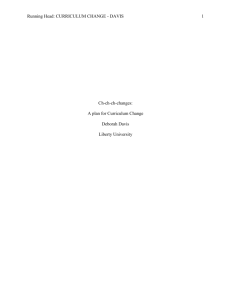Environmental flows elements to support water legislation_MLB
advertisement
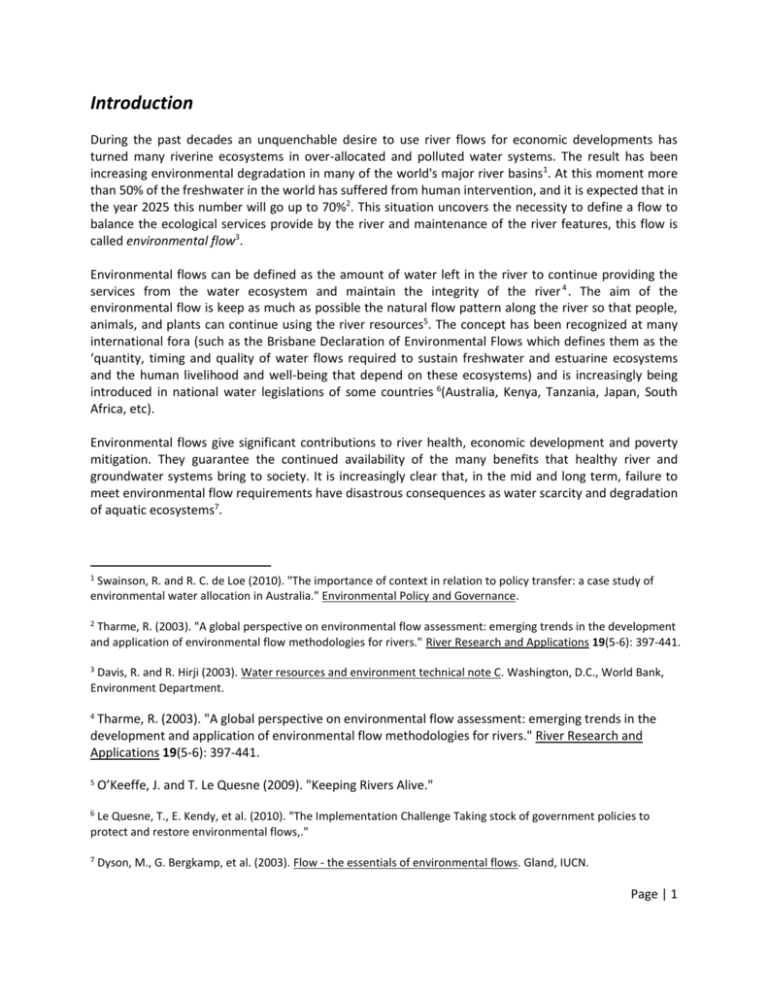
Introduction During the past decades an unquenchable desire to use river flows for economic developments has turned many riverine ecosystems in over-allocated and polluted water systems. The result has been increasing environmental degradation in many of the world's major river basins1. At this moment more than 50% of the freshwater in the world has suffered from human intervention, and it is expected that in the year 2025 this number will go up to 70%2. This situation uncovers the necessity to define a flow to balance the ecological services provide by the river and maintenance of the river features, this flow is called environmental flow3. Environmental flows can be defined as the amount of water left in the river to continue providing the services from the water ecosystem and maintain the integrity of the river 4 . The aim of the environmental flow is keep as much as possible the natural flow pattern along the river so that people, animals, and plants can continue using the river resources5. The concept has been recognized at many international fora (such as the Brisbane Declaration of Environmental Flows which defines them as the ‘quantity, timing and quality of water flows required to sustain freshwater and estuarine ecosystems and the human livelihood and well-being that depend on these ecosystems) and is increasingly being introduced in national water legislations of some countries 6(Australia, Kenya, Tanzania, Japan, South Africa, etc). Environmental flows give significant contributions to river health, economic development and poverty mitigation. They guarantee the continued availability of the many benefits that healthy river and groundwater systems bring to society. It is increasingly clear that, in the mid and long term, failure to meet environmental flow requirements have disastrous consequences as water scarcity and degradation of aquatic ecosystems7. 1 Swainson, R. and R. C. de Loe (2010). "The importance of context in relation to policy transfer: a case study of environmental water allocation in Australia." Environmental Policy and Governance. 2 Tharme, R. (2003). "A global perspective on environmental flow assessment: emerging trends in the development and application of environmental flow methodologies for rivers." River Research and Applications 19(5-6): 397-441. 3 Davis, R. and R. Hirji (2003). Water resources and environment technical note C. Washington, D.C., World Bank, Environment Department. 4 Tharme, R. (2003). "A global perspective on environmental flow assessment: emerging trends in the development and application of environmental flow methodologies for rivers." River Research and Applications 19(5-6): 397-441. 5 O’Keeffe, J. and T. Le Quesne (2009). "Keeping Rivers Alive." 6 Le Quesne, T., E. Kendy, et al. (2010). "The Implementation Challenge Taking stock of government policies to protect and restore environmental flows,." 7 Dyson, M., G. Bergkamp, et al. (2003). Flow - the essentials of environmental flows. Gland, IUCN. Page | 1 Numerous reports that analyze the role and assessment of the environmental flows indicate that a key characteristic to a good environmental flows assessment is national legislation that would make viable a water management that provides for humans being as environmental flows through regulations and guidelines. In this context the paper center its analysis in environmental flow law making experience in countries where they are considered by international reports as well established to identify if exist gaps between e-flow operationalization and what it is written in water laws. The purpose of this review is to determine which elements should have been considered in order to strength the implementation and operationalization of e-flow concept. As a result of this analysis a list of element is extract that in opinion of the authors could increase the implementation opportunities; afterwards this framework will be applied to the new Peruvian water law to critically analyze the relevance and tools that this new law is proposing to tackle operationalization of e-flows. Page | 2 Elements that support environmental flows in Water legislations to protect ecosystem The paper builds up the research around the opportunities and barriers faced for water laws in the attempt to implement environmental flows in different country context. The identification of the opportunities and barriers were use to infer with elements should be included in the framework to lead an effective implementation. The research method selected was literature review which was suitable for the timeframe available of the research. For this research secondary data was consulting such as published data, reports on environmental flows in water law, environmental flows implementation, role water management and practice, stakeholder participation, and primary data such as national water policies and plans. A special attention was pay to the barriers to achieve operationalization of environmental flows. These obstacles identified were check with the law to analyze if changes or specifications in the acts could lead a better and more effective implementation. As a result of this analysis a list of nine elements were obtained as relevant to have in consideration in water laws and acts to make viable the implementation and operationalization of environmental flows. Bearing these shortcomings in mind, there is visibly require for improving existing environmental flow acts. Although the most vital and central research gap is that of understanding the links between e-flow and ecosystem functions, human welfare and socioeconomic benefits, the intention of the existing research is not to solve this gap. Rather, it will build on existing knowledge to extract lessons learnt create a guide framework which will be use to critically analyze and assess the Peruvian water law regarding e-flows performance. Recognition and Acknowledgment Recognition of the importance of environmental flows The rising concern to protect the integrity of water ecosystem has force to include in water management environmental flows. There is no a universal agreed on environmental flows definition in this paper we accept the definition according to the Brisbane declaration8 in which they are described as the "quantity, timing and quality of water flows required to sustain freshwater and estuarine ecosystem and the human's livelihood, and well being that depends on these ecosystems". Environmental flow acknowledgment varies from country to country in South Africa the Water Act (DWAF 1998) coined the term Reserve which stands for human and environmental requirements for present and future generations in Australia the National Water Initiative (NWI) and the Council of Australian Governments recognize environmental flows as legitimate water users9; Moreover in Italy the environmental flows are 8 (2007). "The Brisbane Declaration." Water : official journal of the Australian Water and Wastewater Association. 34(8): 34-35. 9 Hirji, R. and R. Davis (2009). Environmental flows in water resources policies, plans, and projects : findings and recommendations. Washington, D.C., World Bank. Page | 3 considered as framework law and they stand as minimum in stream flows to be present downstream of water diversions10. These three countries are considered by Moore in the group of countries in which eflows work is well established. The diverse approach that these three countries have is an example of how new of e-flows concept is an indicative that has not been understood completely. Since Brisbane declaration, countries around the world started to modify the national policies together with legislation to recognize environmental flows(Dyson, Bergkamp et al. 2003). According to Flows(2003) the first step to increase feasibility of e-flows is to acknowledge their existence and socioeconomic relevance in an integrative water management. Countries such as South Africa and Tanzania recognize environment water as any other consumptive use, as any other use is subject to prioritization to guarantee their allocation these two countries also give first priority in use to them. Other countries such as Australia and Kenya agree with e-flows recognition although they don't assign first priority to environment water because state that prioritization is difficult to put in practice (Hirji and Davis 2009). This two different positions among the historical pioneers on e-flows recognition show that there are many alternatives to protect environment water as long the main principle to secure water for humans and environment for present and future generations remain as the frame of the water management. Now some criticism has risen since integrative water management has to secure water for environment as for humans, for example some villagers in South Africa perceive the e-flows as water for fish (Van Koppen, Jha et al. 2002) which is a common misperception. To avoid this Hirji and Davis (2009) recommend to make evident the link between environment conservation to health improvement and social benefits. Reports from the World Bank and IUCN (2003) indicate that clear identification of the benefits from secure environment water stimulate the participation and compromise of the people specially villagers and small farmers. Social and Cultural Aspects Stakeholder participation mechanism Participation is a largely an information - dissemination exercise among government departments and implementing agencies with the opportunity to comment (Acreman and Ferguson 2010). It generates trust and empowerment among stakeholders and creates respect and support for the decision-making process11. While stakeholder participation can help generate networks of water arrangements, bringing dynamism as well as publicity to the water sector(Dyson, Bergkamp et al. 2003); this needs to be tailored to fit stakeholder capacities (Le Quesne, Kendy et al. 2010). In e-flows assessment stakeholder involvement is essential at every stage (regulating, planning, implementing) in order to design objectives and scenarios around stakeholder requirements12. As such stakeholder involvement needs to be a required by water Laws at what extent, and at which stage depends on the socio-political context of each country and the existing capacities (understanding, funding, and technology). This last 10 Stefano Maran, Environmental Flows and Integrated Water Resource Management: the Vomano River case study 11 Iza, A. O. and R. Stein (2009). Rule : reforming water governance. Gland, Switzerland, The World Conservation Union IUCN Water Nature, Initiative 12 King, J. and C. Brown (2010). "Integrated basin flow assessments: concepts and method development in Africa and South east Asia." Freshwater Biology 55(1): 127-146. Page | 4 consideration is especially important because sometimes stakeholder participation can turn into an impediment to the implementation13. An example of this had been observed in the South African Water Act implementation which sometimes was delayed because participation hearings didn't match small emerging farmer's capacities creating difficulties understanding concept such as Reserve, licensing, relocation and over-allocation 14 . Particularly in the South African Water Act could be add that participation is required at every stage of water management decision resulting which would be consider a trigger to contribute in slowing down implementation15. On the other hand, Tanzania water policy doesn't require explicit stakeholder's involvement and had achieved the formalization of nine rivers and a lake basin organization16 and several environmental flow initiatives are under way or have advanced in anticipation of (river basin) water resources management plans17 Institutional Arrangement Institutional arrangements need to set understandable requirements for efficient and transparent institutions and rules for water allocation (Le Quesne, Kendy et al. 2010). A strengthen legal and institutional framework increase the capacity of water governance, which could support an effective water management to provide water for human being and environment (Dyson, Bergkamp et al. 2003). Therefore a clear set of responsibilities, regulations, acts are needed to impulse an implementation of e-flows. Even though institutional arrangement set ups are being generally described by different authors (Le Quesne, Hirji, King and Brown, Iza) what we can state that clear responsibilities, task and roles are required to support an effective e-flows implementation. For example in Kenya’s water legislation a clear institutional reform was set to facilitate effective implementation this included the creation of an independent Water Resources Management Authority at national level and the establishment of six Catchment Area Advisory Committees, at a regional level 18 .. A strong institutional arrangement is not only meant to implement environmental flows but also to achieve an integrative water management. In addition, Hirji 19 suggests that an independent authority should be in place to measure the performance of the environmental flows arrangement. This brings a sense of fairness and transparency in the process(Davis and Hirji 2003). 13 Hirji, R. and R. Davis (2009). Environmental flows in water resources policies, plans, and projects : findings and recommendations. Washington, D.C., World Bank. 14 Ibid. 15 Ibid. 16 Ibid. 17 Ibid. 1818 Le Quesne, T., E. Kendy, et al. (2010). "The Implementation Challenge Taking stock of government policies to protect and restore environmental flows,." 19 Hirji, R. and R. Davis (2009). Environmental flows in water resources policies, plans, and projects : findings and recommendations. Washington, D.C., World Bank. Page | 5 Environmental Water Mechanism Set of environmental quality objectives The environmental quality objectives are quantifiable criteria to be applied for monitoring the accomplishment of the implementation of environmental flows and may relay to the quality and quantity of water, the habitat and the biota. For example, environmental quality objectives for a river site may be that the river should stay sediment free and that a particular species composition be as in the natural state (Dickens 2011). Carefully setting environmental quality objectives could facilitate the monitoring activities because would narrow the criteria of which elements asses in order to verify the achievement of the e-flows, if with less elements is possible to evaluate the state of the river less cost would be required, which can be the difference between failure or success implementing e-flows. Examples of provision to set environmental quality objectives can be found in the European Water Framework(WFD) as Acreman(2010) stated that the WFD is thus a specific approach to setting objectives for river restoration in which the focus is on ecological outcomes. The European Framework Directive focuses only one environmental objective "good ecological status" for all its water bodies. In cases like South African Water Law (DWAF 1998) and Water Resources Management Act of 2009 is necessary first to establish a national classification system to then set the environmental quality objective for every water body to facilitate the management and monitoring of water resources. On the other hand the Australian and Florida water frameworks don't set classification system or environmental quality objectives at national level instead the environmental objectives are set at basin level according to water allocation plans and local, national and international environmental quality objectives20. Licensing The licensing process has as an end to register the number users and types of uses. The objectives to register thought licenses are to: manage and control water resources for planning and management, protect water resources of over-use, ensure fair distribution among users (DWAF 1998). The existent or new licenses need to support the desired configuration of protect environmental flows in order to operationalize them. Some examples of new types of licenses had been tried by the Water European Framework Directive: time limited and license trading (Acreman and Ferguson 2010). In the case of time limited license currently the WFD grant a license for a period of 12 years, finalized the granting period the license is revaluated and the in the license trading is a way to exchange water rights in times of drought and if water right holder wants. According to Le Quesne (2010) licenses need to be link with water availability (surface and groundwater) and support by water balance models these requirements would contribute to the basin planning water management process. The acceptance of new types of license and regulation for water abstractions in favor of environment water is one of the most difficult challenges of the environmental flows implementation21. Because of most of the river are already over-allocated (Tharme 2003) and once over-allocation is achieved it is 20 Ibid. 21 Le Quesne, T., E. Kendy, et al. "The Implementation Challenge." Page | 6 difficult and political unpopular to recover the water for the environment22. Recover water in overabstracted river remains as number one obstacle in the e-flows implementation Alternatives to deal with over-allocation are incentives to buy existent water uses and water markets to trade water rights(Le Quesne, Kendy et al. 2010). Data Assessment Environmental flow assessment methods There are more than 200 existing methods for determining an environmental flow (Tharme 2003). Lookup tables and desk-top analysis for environmental flow assessment are used in scoping studies, national audits or river basin planning(Le Quesne, Kendy et al. 2010). Functional analysis and habitat modeling are the most widely applied approaches in impact assessment or restoration planning for single or multiple stretches of a river(Davis and Hirji 2003). These assessment methodologies can contribute to setting management rules and monitoring their impact on river health23. The majority of the countries that include environmental flows in their law require the "best available science" to assess them24. In the case of Australia, the Council of Australian Government and National Water Initiative (NWI) required as a national principle to use the best available science to assess the environmental flow requirements (Hirji and Davis 2009) The methods in Australia are centered in the use of panel experts such as the Expert Panel Assessment Method and more sophisticated have emerged like the Flow Restoration Method (Marchand and Wegen 2003) On the other hand in South African Water Act (DWAF 1998) there is no mention about the "best available science to determine environmental flows". However the Department of Water and Forestry affairs (DWAF) was the first to adopt a hierarchy of methods varying in complexity to assess e-flows. Developing 4 levels (desktop, rapid, intermediate, or comprehensive) currently in South Africa the number of assessment method to determine environmental flow is enormous being almost 90 different methods have been developed in South Africa since the Water Act of 1998 (Dickens 2007) being the Building Block Methodology (BBM) the most important contribution in terms of holistic methods which is one of two methods that are routinely applied to determine the e-flows and which is support with a manual(Marchand and Wegen 2003). As experience shows include the premise best available science in water laws or not has the same result exceptional approaches according to the requirements of countries But which defined as best available science from a develop country to may vary to a developing country and therefore the "best available science" requirement might lead to a lot of debate. Being convenient define that the priority of the 22 Hirji, R. and R. Davis (2009). Environmental flows in water resources policies, plans, and projects : findings and recommendations. Washington, D.C., World Bank. 23 Dyson, M., G. Bergkamp, et al. (2003). Flow - the essentials of environmental flows. Gland, IUCN. 24 Hirji, R. and R. Davis (2009). Environmental flows in water resources policies, plans, and projects : findings and recommendations. Washington, D.C., World Bank. Page | 7 method established would be to determine e-flows according environmental, social and economic benefits in order to search for the best fit. Monitoring Mechanism Monitoring mechanism enables to control the delivery of environmental flows in the river and demonstrate their contribution to ecological, social and economic benefits, to increase knowledge in order to refine e-flows (Dickens 2011) . The monitoring provisions should include accessibility of information, frequency of monitoring activities and the responsible authority (Le Quesne, Kendy et al. 2010). Monitoring programs should therefore include hydrological data (historical series, discharge), hydraulic features (river depth, vegetation) as well as environmental outcomes (aquatic ecosystem, environmental services)25. Davis26 found that monitoring considerations in water laws are particular important given the general poor understanding of the links between flows and ecological responses. In addition, King and Brown27 stated that monitoring programs in water laws will test the efficacy of the environmental flows release and will help to determine if adjustments are necessary, to meet ecological and social targets. If monitoring is not prescribed in water law there is no certainty to how e-flows would be measure, you cannot manage what don't measure. Examples of monitoring provision can be found in the South African Water Act of 1998 which requires the monitoring system to collect information on: water quantity and quality, water resources use, rehabilitation of water resources, compliance with the quality objectives, health conditions of aquatic ecosystem and atmospheric conditions that may affect water resources28. And the Tanzanian water policy which contemplate trans-boundary, reserve and environmental quality objectives monitoring. Reinforcement mechanism to support the environmental flows Enforcement, which is needed when voluntary compliance fails, fosters security amongst stakeholders (Hirji and Davis 2009). The State may use police action to assure compliance with a specific law or act29. 25 Ibid. 26 Davis, R. and R. Hirji (2003). Water resources and environment technical note C. Washington, D.C., World Bank, Environment Department. 27 King, J. and C. Brown (2010). "Integrated basin flow assessments: concepts and method development in Africa and South east Asia." Freshwater Biology 55(1): 127-146. 28 DWAF (1998). The National Water Act. Pretoria, Department of Water Affairs and Forestry. 29 Iza, A. O. and R. Stein (2009). Rule : reforming water governance. Gland, Switzerland, The World Conservation Union IUCN Water Nature, Initiative Page | 8 Therefore water law should include provision to reinforce, e.g. sanction and penalties in case that environmental flows implementation activities are not applied this could force the implementation instead if there are no consequence for no protect the e-flows (e.g. penalties, sanctions, or monetary fees) how water agencies would persuade pre-existing behaviors and consider river health, vegetation, sediments, etc. Economic Aspect Financial mechanism to invest in capacity and research of environmental flows assessment According to Dyson (2003) environmental flows will be accepted when the change in flow regime proves to improve markets in social, environmental and economic conditions or instead will exacerbate social inequities. This premise make e-flows a constant fight between the status quo of over-exploitation or doing it what is right for environment. In addition Le Quesne30 states a general notion that the establishment of sustainable financial mechanisms is required to effectively implement e-flows. But a clear definition of what is sustainable is not specific. From our experience it can be said that financial mechanism for e-flow should be cost-recovery as any other project in order to guarantee e-flows implementation. The financial mechanism should enable the research, assessment, monitoring and enforcement of environmental flows as all of these activities cost money. To recover the costs different forms of financial mechanism exist e.g. market trade, charges, taxation, fees. Environmental flows implementation should also lead to re-allocation of water from current uses and users to environment through monetary incentives from government to users to trade their water entitlements31. Only in the last decade the possibilities of using water markets to transfer water temporarily or permanently begun to be used32. Trading of water from one use to another is not a universal phenomenon, but formal and informal markets exist in a number of countries, including Mexico, India, Pakistan, Chile, the USA and Australia33. In the case of Australia large quantities of water for environment were bought but until now an active trade market has not been achieved34. 30 Le Quesne, T., E. Kendy, et al. "The Implementation Challenge." 31 Hirji, R. and R. Davis (2009). Environmental flows in water resources policies, plans, and projects : findings and recommendations. Washington, D.C., World Bank. 32 Dyson, M., G. Bergkamp, et al. (2003). Flow - the essentials of environmental flows. Gland, IUCN. 33 Le Quesne, T., E. Kendy, et al. (2010). "The Implementation Challenge Taking stock of government policies to protect and restore environmental flows,." 34 Hirji, R. and R. Davis (2009). Environmental flows in water resources policies, plans, and projects : findings and recommendations. Washington, D.C., World Bank. Page | 9 To visualize the framework to effective implement environmental flows in water laws a set of classification was made to cluster the elements found through the literature review. Fig 1, shows the cluster and the nine elements, the order in which their arrange has been influenced by how much strong the elements were presented in the literature review. Recognition and Acknowledgment Social and Cultural Aspects Environmental Water Mechanism Data Assesment Economic Aspect Environmental flows Stakeholders participation Inclusion and recognition of the environmental flows in water laws Set of Quality Objectives Methodology Environmental Flows Monitoirng Institutional Arrangements Financial Mechanism License: Allocation Reallocation Reinforcement Page | 10 Environmental Flows in the new water law of Peru 2009 Peru general water policy reform was driven by the need to update the general Water Law of 1969. The water law of 1969 was based on the management of the quantity regardless the quality and the environment degradation. It did not recognize the economic value of the resource and did not recognize as administrate unit the basin. In addition to this driver, the necessity to decentralize the water management (participation of users, national regional and local government in the decisions process) influences the necessity to complete reform the water law. Previously, the institutional arrangement of the Water Law of 1969 was chaotic; the Ministry of Agriculture was in charge of granting all water permits. Due to this the Ministry was centered on agricultural uses, the consequence was the marginalization and no recognition of the private and non-agricultural users. Furthermore, international agreements also had driven the water policy reforms such as UN Conference on the Environment (Stockholm), UN Water Conference in Mar del Plata, Dublin Principles 1992, Rio Declaration and Agenda 21, and World Summit on Sustainable Development. All these elements influence that the Peruvian government changed the water law considering an integrated water management and water for the environment requirements. The new Peru water law enacted in 2009 has as main objective to regulate water uses, water resources management, and the performance of the government and all the parties involved in the water management process. In which the environmental flows are recognized as the volume of water that have to be maintain in water course to protect or conserve water ecosystems, landscape aesthetics and other aspects of scientific and cultural interest. The water law35 is accompanied by a strategy plan36 which includes guidelines, strategies and instruments to guide the actions to have a better water use in Peru in the short, medium and long term, in accordance with the Environment General Law of 1995. The strategy plan is a theoretical instrument in which the objectives of the nation are defined in order to ensure a sustainable water use. Regarding the activities to set environmental flows the strategy plan defines the follow ones: Set the environmental flows specifically for each region of Peru, considering the geographic area, project and context of the river basin; constant assessment of the environmental flows in the river; regulation of sustainable water use; promotion the efficient water use; protection of the ecosystem and establishment of a program to monitor water bodies status. This plan expects an environmental flows implementation between the years 2011-2016 in 5 pilot basins37 follow by a complete implementation in the rest of the country at the year 2020. Recognition of the importance of environmental flows to protect river health and to guaranty the continuity of human benefits The environmental flows are defined in the Peru water law38 as the "volume of water that has to be maintained in the river to conserve water ecosystems, landscape aesthetics and other aspects of 35 MINAG (2009). Water Law Lima. Lima, Ministry of Agriculture-National Water Authority. 36 MINAG (2009). Policy and National Strategy of the Water Resources in Perú. Lima. 37 Ibid. 38 MINAG (2009). Water Law Lima. Lima, Ministry of Agriculture-National Water Authority. Page | 11 scientific and cultural interest”. The environmental flows need to remain in the river and can't be used under any circumstance for consumptive uses. However the prioritization doesn't include the environmental flows as a user. First priority is given to supply basic needs as cooking and bathing extracting directly from the source without infrastructure, second is for domestic use (water distributed by pipelines) and third is for productive water uses (agriculture, aquaculture, hydropower, industrial, health, mining, recreational, tourist and transport). The water law doesn't rank the environmental flows in the prioritization list the water law is unclear to protect the e-flows. The Peruvian water law recognizes environmental flows as a tool to conserve water ecosystem, but they are isolate in the law. There is no clear relationship between water for environment and social and economic benefits but doesn't make clear a link between river health and social benefits. This is relevant according to the framework to achieve an efficient implementation. As the link to the delivery of goods and services for the people is missing the recognition of the environmental flow concept is weak (Castillo39). To improve the effectiveness of the environmental flows concept the Peruvian water law should include a link to health and a prioritization that which according to our framework are the first steps to consider serious changes in the water management of a country. Licensing process A license provision is subject to a hydrological study (water use plan and hydrology study) that proves that there is enough water available to guarantee environmental flows, consumptive uses, native and peasant communities uses. After verifying the accuracy of the hydrological study the license is granted by the National Water Authority. This means that the license is granted only if it doesn't affect the environmental flows but without a priority how the environmental flows can be use to control whose gets or not a water license. The uses subject to licenses are domestic use (water distributed by a piping network) and productive water uses (agriculture, aquaculture, hydropower, industrial, health, mining, recreational, tourist and transport). The license process is adequately identified in the Peruvian Water Law as it is conditional to the environmental flows protection. An element that could be introduced to enhance implementation in over-allocated basins is the recognition of the potential of trading water. Environmental flow assessment methodology The law doesn't require "best available science" to assess the environmental flows but requires the responsible authorities (National Water Authority (ANA) and the Ministry of Environment) to assess the environmental. According to the developed framework this is a requisite to enforce that the best expertise and knowledge would be used to develop the assessment. To improve the effectiveness of implementation the Peruvian government should consider including as requisite the best available science to guarantee a continued evolution of the assessment methods. Monitoring Mechanism The law prescribes monitoring, control and surveillance actions to ensure conservation of water sources, goods and services related to them and sustainable use. A monitoring program is not defined so no inclusion of monitoring frequency, monitoring parameters or monitoring objectives relating to 39 Castillo, L. (2009). "Nueva ley de aguas que no convence." Páginas 34(214): 15-21. Page | 12 environmental flows. As such the effectiveness of the water law to protect the ecosystem cannot be analyzed, supported by data nor enforced. The risk of degrading the river will still be present. The Peruvian water law should include details to the monitoring, control and surveillance actions with at least include hydrological data as well as environmental outcomes. As such river depth, vegetation, aquatic ecosystem quantity, discharges, etc. Financial mechanism to invest in capacity and research of environmental flows assessment The law has included some financial mechanism to fund water plans and monitoring programs but does not recognize the cost and benefits of implement environmental flows or water markets to trade water for the environment. This lack of financial mechanism to promote the environmental flows creates uncertainty if the funds to assess, control and enforce will be put in place to guarantee an effective implementation of environmental flows. This makes necessary that the law include financial mechanism to enable research, assessment, monitoring and enforcement of environmental flows. Stakeholder participation mechanism There is no stakeholder participation requirement to define the environmental flows requirements in the water law. This consultation process should need to be considered in order to bring trust in the implementation of the environmental flows. Institutional Arrangement The institutional arrangement in Peru is constituted by a new main national authority the National Water Authority. Additionally, a Water Management Authorities for each of the fourteen hydrological areas, seventy three Local Water Authorities spread in the country. They depend economically from the Ministry of Agriculture which creates doubts regarding political and economical interest in the water management decisions. The authority responsible to implement the environmental flows is not defined. The protection of the water quality is a shared responsibility between the National Water Authority, the Water Management Authority and the Local Water Authority. There is also no consideration of involvement of an independent authority to assess implementation performance. In Peru this is especially recommended having as the ministry in charge of the water management and therefore environmental flows at the Ministry of Agriculture which is one of the major users40. The water law does not provide clear division of functions and responsibilities and the inclusion of an independent authority to assess the level of achievement of the environmental flows implementation. In order to increase the effectiveness clear mandate regarding the authority to control the environmental flows and the possibility to have an oversight authority should need to be included in the water law. Conclusion Solely inclusion in water laws doesn't ensure successful implementation of environmental flows, but legal recognition is a prerequisite41. Based on an extensive literature review nine elements were found 40 MINAG (2009). Policy and National Strategy of the Water Resources in Perú. Lima. 41 Dyson, M., G. Bergkamp, et al. (2003). Flow - the essentials of environmental flows. Gland, IUCN. Page | 13 that need to be prescribed in a Water Law to effectively protect the ecosystem through the concept of environmental flows. Recognition of the importance of environmental flows to protect river health and to guaranty the continuity of human benefits; this element tries to identify how the law defines the environmental flows and if their importance is emphasized with prioritization. Set environmental flow objectives; this provision tries to identify if classification system or quality objective to manage the resources have been included in the laws. Environmental flow assessment methodology, regarding the environmental flows assessment the laws should consider to request for the best available science in order to guarantee a high level of understanding of the problem. Licensing process, this provision should operationalize the environmental flows, allowing that only uses that no affect the integrity of the environmental flows could get a license. Monitoring Mechanism, activities require by law to control, assess, and identify if the environmental flows are being delivered and if the social benefits have been achieved. Financial mechanism to invest in capacity and research of environmental flows assessment Stakeholder participation mechanism; this element requires to involve the stakeholders to promote a fair process, including their requirements while setting the environmental flows requirements. Institutional Arrangement, this element require that clear mandate should need to be establish in the law; avoiding overlapping and including the intervention of an oversight authority to measure performance. Reinforcement activities, this element tries to identify in the law provisions to force compliance such as sanctions, penalties and charges. The key elements identified in this framework will not only ensure environmental flows implementation but also be of value for integrated water management where clear management and responsibilities are required. The new Peruvian water law recognizes the concept of environmental flow, but omits most of the other elements. Repeat the elements present and missing. The recognition of environmental flows in the Peru water legislation might be one of the most remarkable features that this one has because in the previously water law of 1969 water quantity was the only aspect considered as important in the water management. However, as a recently enacted law (2009) and considering the current level of understanding regarding environmental flows in the scientific community, this law misses almost essential elements making it unlikely that protection of the ecosystem will be guaranteed. (2007). "The Brisbane Declaration." Water : official journal of the Australian Water and Wastewater Association. 34(8): 34-35. , Forslund, A. (2010). How are environmental flows adapted and reflected in global, regional and national policy frameworks. What are the demands from a policy perspective and how can science deliver what is needed?, Swedish Water House (SWH) and World Wide Fund for Nature (WWF), Sweden. Page | 14 Acreman, M. and A. Ferguson (2010). "Environmental flows and the European water framework directive." Freshwater Biology 55(1): 32-48. Castillo, L. (2009). "Nueva ley de aguas que no convence." Páginas 34(214): 15-21. Davis, R. and R. Hirji (2003). Water resources and environment technical note C. Washington, D.C., World Bank, Environment Department. Dickens, C. (2007). Obstacles to the implementation of environmental flows. Dickens, C. (2011). Critical analysis of environmental flow assessments of selected rivers in Tanzania and Kenya. Nairobi, Kenya: IUCN ESARO office and Scottsville, South Africa. DWAF (1998). The National Water Act. Pretoria, Department of Water Affairs and Forestry. Dyson, M., G. Bergkamp, et al. (2003). Flow - the essentials of environmental flows. Gland, IUCN. Forslund, A. (2010). How are environmental flows adapted and reflected in global, regional and national policy frameworks. What are the demands from a policy perspective and how can science deliver what is needed?, Swedish Water House (SWH) and World Wide Fund for Nature (WWF), Sweden. Hirji, R. and R. Davis (2009). Environmental flows in water resources policies, plans, and projects : findings and recommendations. Washington, D.C., World Bank. Iza, A. O. and R. Stein (2009). Rule : reforming water governance. Gland, Switzerland, The World Conservation Union IUCN Water Nature, Initiative King, J. and C. Brown (2010). "Integrated basin flow assessments: concepts and method development in Africa and South east Asia." Freshwater Biology 55(1): 127-146. Le Quesne, T., E. Kendy, et al. "The Implementation Challenge." Le Quesne, T., E. Kendy, et al. (2010). "The Implementation Challenge Taking stock of government policies to protect and restore environmental flows,." Marchand, M. and M. v. d. Wegen (2003). Environmental flow requirements : an integrated approach for river and coastal zone management. Delft,. MINAG (2009). Policy and National Strategy of the Water Resources in Perú. Lima. MINAG (2009). Water Law Lima. Lima, Ministry of Agriculture-National Water Authority. O’Keeffe, J. and T. Le Quesne (2009). "Keeping Rivers Alive." Swainson, R. and R. C. de Loe (2010). "The importance of context in relation to policy transfer: a case study of environmental water allocation in Australia." Environmental Policy and Governance. Page | 15 Tharme, R. (2003). "A global perspective on environmental flow assessment: emerging trends in the development and application of environmental flow methodologies for rivers." River Research and Applications 19(5-6): 397-441. Van Koppen, B., N. Jha, et al. (2002). "Redressing racial inequities through water law in South Africa: Revisiting old contradictions." Comprehensive Assessment Research Paper no 3. Page | 16
